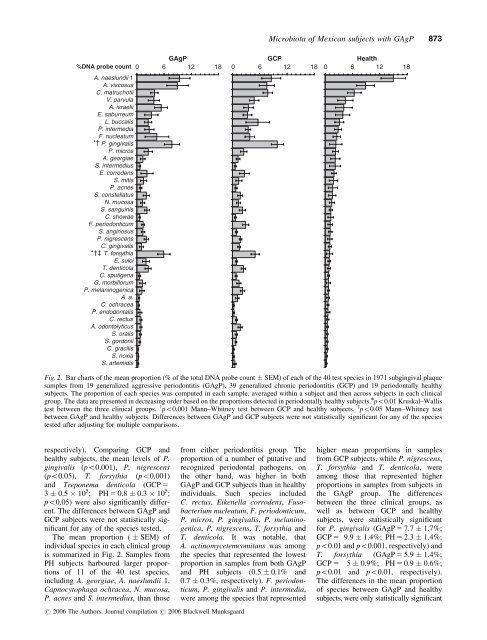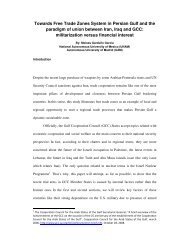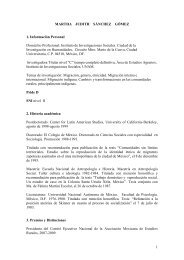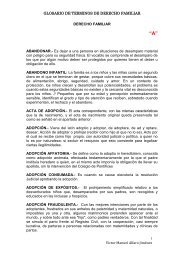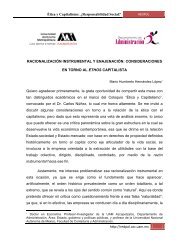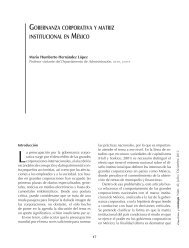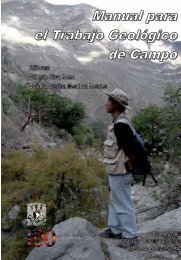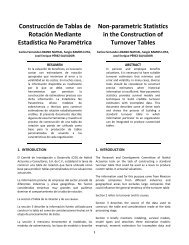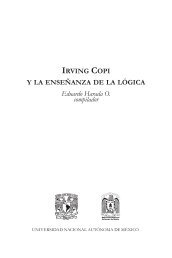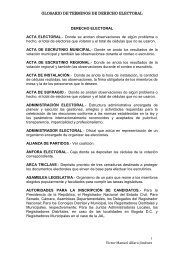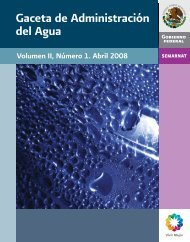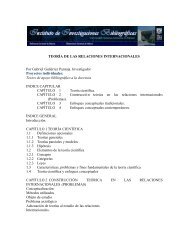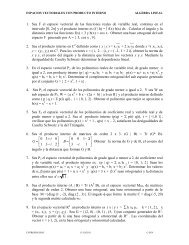PDF(145K) - Wiley Online Library
PDF(145K) - Wiley Online Library
PDF(145K) - Wiley Online Library
You also want an ePaper? Increase the reach of your titles
YUMPU automatically turns print PDFs into web optimized ePapers that Google loves.
Microbiota of Mexican subjects with GAgP 873<br />
GAgP<br />
GCP<br />
Health<br />
%DNA probe count 0 6 12 18 0 6 12 18 0 6 12 18<br />
A. naeslundii 1<br />
A. viscosus<br />
C. matruchotii<br />
V. parvula<br />
A. israelii<br />
E. saburreum<br />
L. buccalis<br />
P. intermedia<br />
F. nucleatum<br />
*† P. gingivalis<br />
P. micros<br />
A. georgiae<br />
S. intermedius<br />
E. corrodens<br />
S. mitis<br />
P. acnes<br />
S. constellatus<br />
N. mucosa<br />
S. sanguinis<br />
C. showae<br />
F. periodonticum<br />
S. anginosus<br />
P. nigrescens<br />
C. gingivalis<br />
*†‡<br />
T. forsythia<br />
E. sulci<br />
T. denticola<br />
C. sputigena<br />
G. morbillorum<br />
P. melaninogenica<br />
A. a.<br />
C. ochracea<br />
P. endodontalis<br />
C. rectus<br />
A. odontolyticus<br />
S. oralis<br />
S. gordonii<br />
C. gracilis<br />
S. noxia<br />
S. artemidis<br />
Fig. 2. Bar charts of the mean proportion (% of the total DNA probe count SEM) of each of the 40 test species in 1971 subgingival plaque<br />
samples from 19 generalized aggressive periodontitis (GAgP), 39 generalized chronic periodontitis (GCP) and 19 periodontally healthy<br />
subjects. The proportion of each species was computed in each sample, averaged within a subject and then across subjects in each clinical<br />
group. The data are presented in decreasing order based on the proportions detected in periodontally healthy subjects. n po0.01 Kruskal–Wallis<br />
test between the three clinical groups. w po0.001 Mann–Whitney test between GCP and healthy subjects. z po0.05 Mann–Whitney test<br />
between GAgP and healthy subjects. Differences between GAgP and GCP subjects were not statistically significant for any of the species<br />
tested after adjusting for multiple comparisons.<br />
respectively). Comparing GCP and<br />
healthy subjects, the mean levels of P.<br />
gingivalis (po0.001), P. nigrescens<br />
(po0.05), T. forsythia (po0.001)<br />
and Treponema denticola (GCP 5<br />
3 0.5 10 5 ; PH5 0.8 0.3 10 5 ;<br />
po0.05) were also significantly different.<br />
The differences between GAgP and<br />
GCP subjects were not statistically significant<br />
for any of the species tested.<br />
The mean proportion ( SEM) of<br />
individual species in each clinical group<br />
is summarized in Fig. 2. Samples from<br />
PH subjects harboured larger proportions<br />
of 11 of the 40 test species,<br />
including A. georgiae, A. naeslundii 1,<br />
Capnocytophaga ochracea, N. mucosa,<br />
P. acnes and S. intermedius, than those<br />
from either periodontitis group. The<br />
proportion of a number of putative and<br />
recognized periodontal pathogens, on<br />
the other hand, was higher in both<br />
GAgP and GCP subjects than in healthy<br />
individuals. Such species included<br />
C. rectus, Eikenella corrodens, Fusobacterium<br />
nucleatum, F. periodonticum,<br />
P. micros, P. gingivalis, P. melaninogenica,<br />
P. nigrescens, T. forsythia and<br />
T. denticola. It was notable, that<br />
A. actinomycetemcomitans was among<br />
the species that represented the lowest<br />
proportion in samples from both GAgP<br />
and PH subjects (0.5 0.1% and<br />
0.7 0.3%, respectively). F. periodonticum,<br />
P. gingivalis and P. intermedia,<br />
were among the species that represented<br />
r 2006 The Authors. Journal compilation r 2006 Blackwell Munksgaard<br />
higher mean proportions in samples<br />
from GCP subjects, while P. nigrescens,<br />
T. forsythia and T. denticola, were<br />
among those that represented higher<br />
proportions in samples from subjects in<br />
the GAgP group. The differences<br />
between the three clinical groups, as<br />
well as between GCP and healthy<br />
subjects, were statistically significant<br />
for P. gingivalis (GAgP 5 7.7 1.7%;<br />
GCP 5 9.9 1.4%; PH 5 2.3 1.4%;<br />
po0.01 and po0.001, respectively) and<br />
T. forsythia (GAgP 5 5.9 1.4%;<br />
GCP 5 5 0.9%; PH 5 0.9 0.6%;<br />
po0.01 and po0.01, respectively).<br />
The differences in the mean proportion<br />
of species between GAgP and healthy<br />
subjects, were only statistically significant


